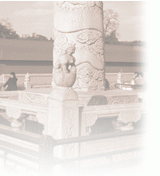|
The study of chestnut leave withering
chaired by the Zunhua Municipal Forestry Bureau has passed
recent experts' verification. The study classified chestnut
leave withering symptoms and types and worked out the
solutions for prevention and treatment.
In
1995, researchers discovered a new chestnut tree disease in
the Yanshan area, a major chestnut production base. Once
being attacked, the chestnut trees will be seriously
affected on an extensive basis, causing the reduction of
both yield and quality. Researchers started the study from
2000 and found that the withering is mainly caused by either
the excessive application of boron or by potassium
insufficiency. The solutions are therefore controlling the
boron application and making up the needed potassium. The
control process has found main expressions in controlling
the application of boron with no more than 15g of boron be
annually applied over per square meter of the chestnut
canopy and increasing the application of organic
fertilizers. The boron applications are measured on every
three year basis so as to define the rational application
volume in line "with the soil and growth conditions.
Potassium insufficiency can be addressed mainly
through satisfying the demand of chestnut trees by spraying
potassium in an amount of 20g per square meter canopy a
year. The desirable application time is the late June or
early July. In addition, the growth agent is advised to be
applied over tree leaves with a frequency of 2 — 4
times a year. The three — year consecutive experiments
and diffusions over Zunhua area, Hebei Province and Huairou
area, Beijing have demonstrated fine economic retunes.
|



